East Wales and its Nature Reserves
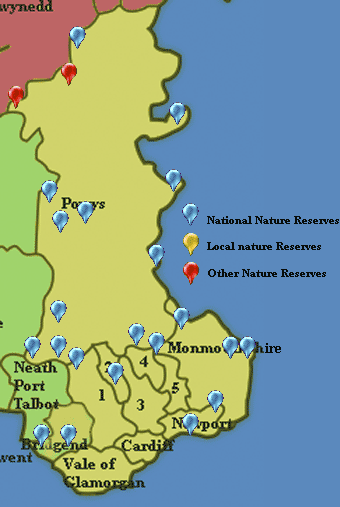
Wildlife, landscapes and ecology
The regional divisions of Wales used on this website follow those adopted by Natural Resources Wales (NRW), the organisation with key responsibility for the designation and management of our Areas of Outstanding National Beauty, Nature Reserves, National Parks and countryside in general. To help you to locate nature reserves and other wildlife habitats, throughout this website 'East Wales' therefore includes the counties of Powys, Monmouthshire, Cardiff, Rhondda-Cynon-Taff, Merthyr Tydfil, Caerphilly, Torfaen, Blaenau Gwent, Newport, Vale of Glamorgan, and Newport.
East Wales is seldom mentioned as a holiday destination in quite the same way that Southwest Wales or North Wales are. This is simply because of the high profile attained by particular parts of the easternmost counties of Wales that makes them destinations in their own right. East Wales is home to the Breacon Beacons National Park, the Wye Valley Area of Outstanding Natural Beauty, the Gwent Levels, the Elan Valley Estate, the Montgomery Canal, and the Black Mountains to name but a few. These are all destinations renowned for their beautiful scenery and exciting wildlife habitats, and in these respects this part of Wales can easily rival the ecology and scenic beauty of North Wales and Southwest Wales.
The Brecon Beacons National Park was the first of Wales's National Parks to be designated (the other two being the Snowdonia National Park, in North Wales, and the Pembrokeshire National Park, in Southwest Wales). Further recognition of the importance of the region's exceptional upland landscape came in 2005 when Forest Fawr Geopark, in the westerly Beacons, became a member of the prestigious European Geopark Network and was given UNESCO Global Geopark status; it was the first Geopark in the United Kingdom to be so designated.
The Severn Estuary is designated both as a Special Protection Area (SPA) and as a RAMSAR Site. (The Ramsar Convention is an intergovernmental commitment to protect wetlands of international importance. More details...) The Montgomery Canal is one of many Special Areas of Conservation (SAC) within East Wales, which also contains some twenty National Nature Reserves (NNR) and numerous Local Nature Reserves (LNR), Wildlife Trust nature reserves, RSPB reserves and other sites managed by other non-governmental organisations and local communuty groups.
Below: Nant Irfon, one of the dramatic river valleys on the eastern edge of the Cambrian Mountains
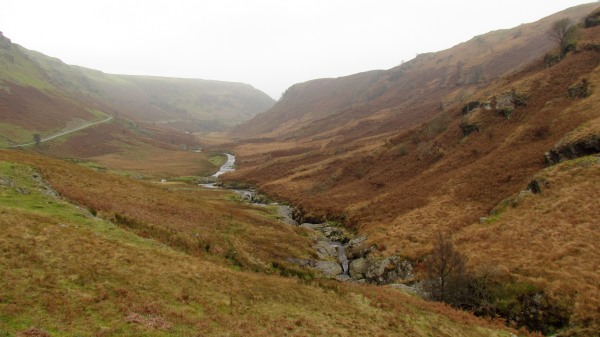
Just to the east of Port Talbot, with its industrial chimneys belching smoke and flames, lies one of the coastal gems of Southwest Wales, Kenfig National Nature Reserve. The stark industrial backdrop to Kenfig NNR only serves to emphasise the wild beauty and peace that can be experienced in any walk through its sand dunes, its woodland areas, beside its freshwater pool, or on the sandy beach. The dune system here is also the last stronghold of one of Britain's rarest plants, the diminutive Fen Orchid, Liparis loeslii.
Kenfig NNR is also a great place to see many other wildflowers as well as the diversity of birds, insects and other animals that live within the varied habitats there.
Kenfig is not the only major dune system in Wales. Many more sand dunes and dune slacks, with their specialised wildlife and ecology, can be found on the coast of Southwest Wales and North Wales including the isle of Anglesey (More details...). Travelling around Wales in a clockwise direction from Kenfig you come to Oxwich Bay, Whitford Burrows, and then Ynys Las. The latter three nature reserves are covered under the NNR list for Southwest Wales...
Below: Buzzards are common throughout Wales, but the Brecon Beacons are a great place to see them.
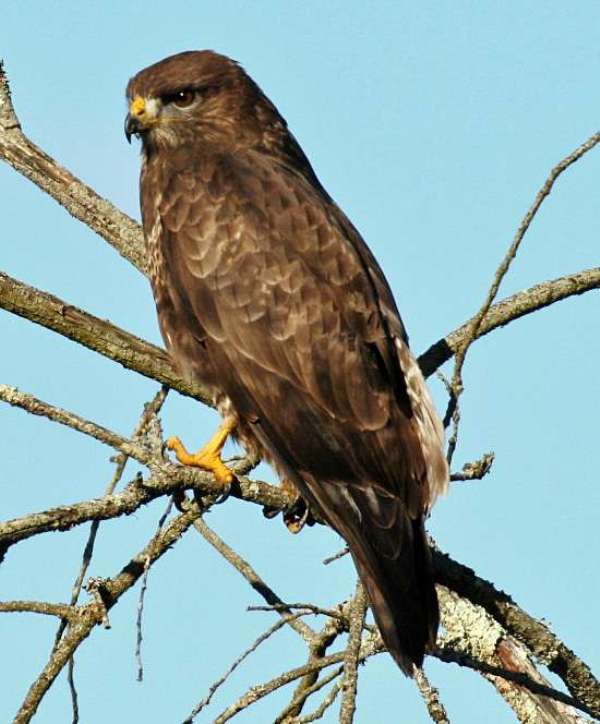
Those familiar with the First-Nature website will know that we have a special interest in wild orchids, and Wales is one of the best places to see them in the UK. The dune slacks in Southwest Wales and East Wales, as well as those in North Wales and Anglesey, have just the right soil substrata to suit many orchid species, and indeed other wildflowers, too. This is because chalk, derived from crushed sea shells, constitutes a high proportion of the soil, and most wild orchids and many other plants need alkaline soil.
Whereas in England you might have to make almost one journey per orchid species, here in Wales you can make one journey to a sand dune nature reserve and see many species flowering together. Kenfig is one example, and has the added bonus of the presence of the Fen Orchid, but at Oxwich and Ynys Las you will do just as well provided you visit at the right time of year.
Some of the orchids you can expect to find are the Early Marsh-orchid (Dactylorhiza incarnata), Common Twayblade (Neottia ovata), Pyramidal Orchid (Anacamptis pyramidalis) and the Fragrant Orchid (Gymnadenia conopsea). Another orchid that thrives in the alkaline dune slacks is the Marsh Helleborine (Epipactis palustris), regarded by many as Britain's most beautiful wild orchid. The Marsh Helleborine normally occurs in wet and marshy grassland. Here in Wales, in dune slacks that are submerged during the winter and early spring, these lovely helleborines find not only the chalk that they require but also the right amount of moisture - they like it wet! Any time from early June to the beginning of July a visit to one of our coastal reserves will guarantee you a wild orchid bonanza.
Brecon Beacons National Park
This National Park, which runs from Hay-on-Wye in the east to Llandeilo in the west, covers an area of more than 130,000 hectares (500 square miles). It is a paradise for bird watchers, geologists and botanists as well as for those who simply enjoy walking in spectacular scenery. The area includes four distinct blocks of hills which are dissected by several rivers including the Honddu, the Grwyne Fecan and Grwyne Fawr, and the Usk.
In the west is the Black Mountain (Y Mynydd Du, in Welsh) not to be confused with the Black Mountains on the eastern edge of the Park, which form a natural boundary with England. In the centre is Forest Fawr, with its series of hills called 'Fans' and from which rivers flow through steep-sided valleys and over impressive waterfalls. This section also has Pen y Fan - at 886 metres the highest summit not just in the Brecon Beacons but in southern Britain.
Towards the southern edge of the Park, the geology alters and limestone outcrops and millstone grit dominate. This is a landscape of ridges and screes with deep hollows, called shakeholes, and below the surface there are massive cave passages decorated with stalagmites and stalactites.
Below: Brecon Beacons National Park Mountain Centre at Libanus, near Brecon
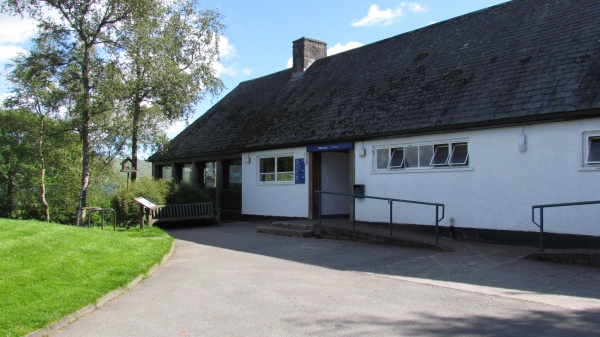
The Brecon Beacons National Park headquarters is in the town of Brecon, and there are two additional centres - the Mountain Centre and the Waterfalls Centre.
The Mountain Centre at Libanus, about 10km (6 miles) south of Brecon on the A470, has a shop and tea rooms. In addition there is a National Park and Tourist Information Centre in the bustling market town of Abergavenny where books, maps and food can be purchased.
Elan Valley Estate
Owned by Welsh Water (Dŵr Cymru), the Elan Valley Estate has been managed to protect the quality and quantity of water in its reservoirs since 1892. The majority of the Estate falls within a Special Protection Area (SPA) because of its birdlife; in addition, it forms part of the Cambrian Mountains Environmentally Sensitive Area and contains 12 separately designated Sites of Special Scientific Interest (SSSI). There are several of National Nature Reserves within the Estate boundaries.
Below: One of the dams at Elan Valley overflows after heavy rain
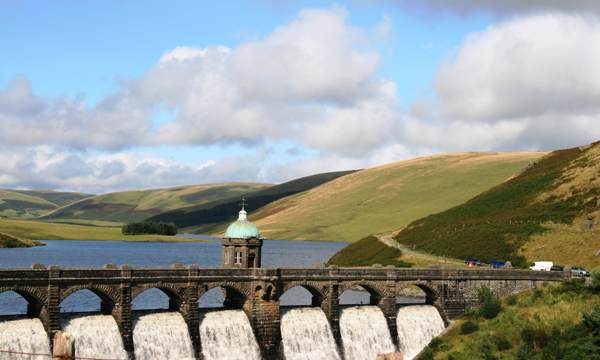
Elan Valley Estate covers an area of rounded hills dissected by steep river valleys, many of which are covered by deciduous woodlands dominated by Sessile Oak. Other wildlife habitats include unimproved pasture, species-rich meadows and upland mire.
Twenty species of mammals make their homes in the Elan Valley Estate, and the 300 species of flowering plants that are recorded there include eight different orchid species (including the rare Bog Orchid). Four of the six British native reptiles, 200 moths and 27 butterfly species, and 180 bird species have been recorded on the Estate. In addition, the old buildings and caves on the Estate are home to six bat species, and it is also well-known for its numerous mosses, ferns, lichens and liverworts. That surely must make the Elan Valley Estate one of the finest locations in Wales for enjoying wildlife.
The Elan Valley Estate Visitor Centre is in Elan Village, west of Rhyader and off the B4518 road; it has a shop, an Information Centre, and a large café all of which are open during the spring and summer. There is a large car park and plenty of places to enjoy a picnic.
The Montgomery Canal
The Montgomery Canal is one of the most important waterways for wildlife in Britain. Much of its 50km (35 mile) length is designated as a Site of Special Scientific Interest (SSSI). The canal was built to provide cheap and easier transport of heavy cargoes for the local landowners and farmers, who had previously depended on horse and cart transport travelling on uneven mud tracks and expensive toll roads.
The canal closed to transport in 1944, and it was not long before nature reasserted itself and it became home to interesting and rare aquatic plants, Otters Lutra lutra, Water Voles Arvicola terrestris, Mute Swans Cygnus olor, and of course numerous invertebrates. Attempts to restore the canal to navigable standards have been dogged with financial problems and the need to protect and preserve the habitat for wildlife. In 1980 the Montgomery Waterway Restoration Trust was formed, and the membership includes the Inland Waterways Association, the Montgomeryshire Wildlife Trust, The Prince's Trust and representatives from several other interested organisations. The Trust also formed 'Friends of the Montgomery Canal' to provide information for and involvement of the people and communities within the canal corridor.
To leave the canal to Mother Nature's care, meaning that it would eventually revert to swamp and woodland, could be as damaging to its existing wildlife populations as unsympathetic restoration. The plans drawn up by the Trust take account of the need to protect wildlife, and so far seven specially designed nature reserves have been created off the side of the main canal with several more planned during future restoration phases. The reserves provide the same environmental conditions as those of the canal itself, which means that important aquatic plants can be moved there, where they can continue to be looked after and monitored. Other animals and insects simply move themselves, and by all accounts they have already done so!
Of particular interest to Botanists, the Mongomery Canal is one of the world's most significant sites for Floating Water Plantain Luronium natans. Notoriously difficult to identify in the absence of flowers, this plant is one of the most highly protected in Britain.
Gwent Levels and Newport Wetlands
The Gwent Levels is an area of ancient grazing marshes and drainage ditches (called reens) lying on the edge of the city of Newport, between Cardiff and Chepstow. The Gwent Levels Wetlands Reserve (Newport Wetlands) was established in 2000 as mitigation for the loss of bird habitat caused by the building of the Cardiff Bay Barrage. The reserve covers 437 hectares and is situated beside the Severn Estuary, which itself is of both national and international conservation importance.
Below: The Gwent Levels in early spring
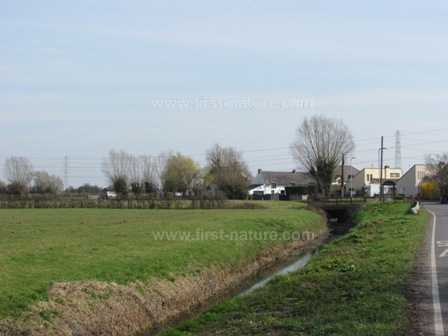
Although some drainage occurs naturally across the site, the Gwent Levels landscape that we see today is one created mainly by Man in an attempt to reclaim land from the tidal saltmarsh running alongside the Severn Estuary. The existing network of reens probably dates from Roman times, but the Levels shows evidence of a variety of landscapes from different historical times, and it is a site of great achaeological interest as well as being a haven for wildlife.
There are numerous Sites of Special Scientific Interest (SSSI) throughout the Levels designated for their plant species; these plants include the nationally scarce Rootless Duckweed (Wolffia arrihiza), considered to the the world's smallest flowering plant. Other interesting plants include Blunt-flowered Rush Juncus subnodulosus, Arrowhead Sagittaria sagittifolia and Flowering Rush Butomus umbellattus. Invertebrate life in the Levels include Nationally Notable or Red Data Book species; and water beetles, dragonflies and damsleflies are qualifying features of the SSSI designations.
The reens hold 25 rare water plants species, and the area is well-known for its range of aquatic liverworts.
The combination of marsh, reens and ancient hedges are excellent habitat for Otters, Water Voles, bats and newts.
The development of Newport Wetlands, owned by the Countryside Council for Wales on behalf of the Welsh Assembly Government and run jointly with RSPB, has increased the focus on birds in the Gwent Levels. There are paths and trails around the Reserve, with easy access for wheelchair users and for prams and pushchairs. There are also a visitor centre with a shop, café, toilets, conference room and classroom facilities where events are run and coordinated throughout the year.
Bird species to look out for on a visit to Newport Wetlands include Bearded Tits Panurus biramicus, Dunlins Calidris alpina, Avocets Recurvirostra avosetta, Little Egrets Egretta garzetta as well as many others; and there is even a chance of seeing the rare Goldeneye Bucephala clangula during the winter. There is more information on the Newport Wetland NNR page...
Below: Pink Waxcaps - Hygrocybe calyptriformis
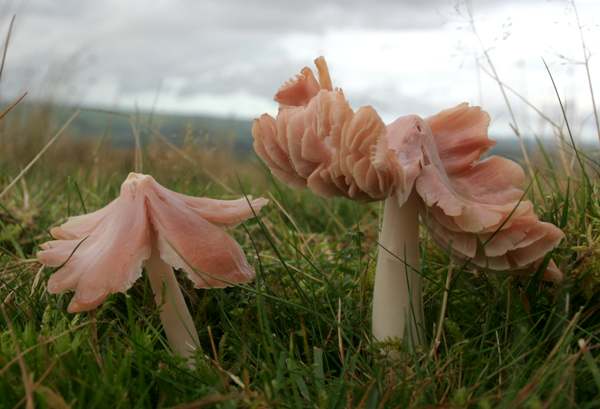
Mynydd Epynt
Mynydd Epynt, or simply Epynt as it is sometimes called, sits between Llandovery and Llanwrtyd Wells off the A483 road. Much of this upland area of Powys was acquired by the Ministry of Defence in 1939 as a place to train soldiers.
This part of Wales is now known as Sennybridge Training Area. Despite it use for military exercises, a number of sections of the land have been designated as Sites of Special Scientific Interest (SSSI), and Special Areas of Conservation (SAC) because of their plant life, and in one sector because of its populations of waxcap fungi. The site is not well-signed and it has no facilitie,s but for anybody with a particular interest in fungi it one of the best places to see some very rare species.
More than 30 different waxcaps have been recorded on Mynydd Epynt, which makes it one of the top grassland fungi sites in Europe.
Waxcaps are often described as 'the orchids of the fungi world' because of their fascinating array of bright colours. While some species are a conventional brown or white, others are yellow, green, orange, scarlet, purple or pink. To catch these fungi at their peak a visit in October is probably best, but be warned: it is a vast open landscape and can be several degrees colder than the lowlands. A warm coat is essential even though you may not need to walk far.
The waxcaps are frequently most abundant by the side of the road and clearly visible in the closely grazed open grassland.
The River Wye and the Wye Valley AONB
The River Wye and some of its tributaries are designated as a Special Areas of Conservation (SAC) and this designation is therefore underpinned by them being Sites of Special Scientific Interest (SSSI).
The source of this 250km (150 mile) long river is on Plynlimon, the highest part of the Cambrian Mountains. From there the Wye flows through some of the most beautiful and dramatic countryside in Britain, finally entering the sea, together with the River Severn, in the Bristol Channel. The Wye was historically known as the most productive wild salmon river in Wales and was famous for its high proportion (around 75%) of very large multi-sea-winter fish. This stock component has declined sharply in recent years, and despite considerable efforts the decline is proving very difficult to reverse. Other important fish species and wildlife are well represented in the Wye and its tributaries, however, and the Wye Valley has dramatic gorges and significant areas of woodland.
Below: Beautiful scenery in the Brecon Beacons
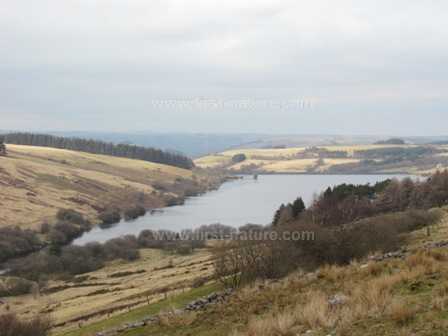
Close to the Wye's source high up in the Cambrians, the vegetation is dominated by mosses, lichens and liverworts, but the lower reaches of the river have extensive beds of Water Crowfoot (Ranunculus species) including River Water-crowfoot, Ranunculus fluitans. Flowering rush Butomus umbellatus, Lesser Water Parsnip Berula erecta and Curled Pondweed Potamogeton crispus are present, as is an excellent range of aquatic flora including River Jelly-lichen Collema dichotu).
The Wye tributaries are a haven for the White-clawed Crayfish Austropotamobius pallipes. The main river also provides excellent habitat for the Sea Lamprey Petromyzon marinus along with Brook Lamprey Lampetra planeri, River Lamprey Lampetra fluviatilis, Twaite Shad Alosa fallax, Allis Shad Alosa alosa, and Bullhead Cottus gobio.
The Wye also holds the most extensive population of Otters Lutra lutra in Wales with particularly good habitat for breeding and abundant and clean water supplies.
The Wye Valley is also well known for some of Britain's most important woodland habitats. The swathe of semi-natural broadleaved woods that run down the length of the Wye Valley from Goodrich to Chepstow contain many magnificent old beech trees at the most westerly extent of their range in Britain. Lady Park Wood, for instance, is highly protected and generally regarded as being one of the finest undisturbed woods of its type anywhere in the UK.
The Wye Valley Woodlands are of incalculable value to wildlife including rare bat species, birds, mammals, reptiles and invertebrates as well as many nationally endangered plants. Indeed the whole of the Wye Valley, with its amazing mosaic of habitats, is a paradise for those with an interest in the natural world of Wales.
Lake Vyrnwy
This man-made lake was created to provide water for Liverpool and Merseyside. The dam, which was the first large stone-built dam in the UK, was completed in 1888. Today, the lake and the surrounding estate forms part of the Y Berwyn (NNR) and is run jointly by RSPB and the Severn-Trent Water Company. Y Berwyn NNR is managed by the CCW, and there is more information about the NNR on the Berwyn NNR page...
Lake Vrynwy is also a Site of Special Scientific Interest (SSSI) and a Special Area of Conservation. The lake, whose circumference is about 17km (11 miles), is fed by some 30 rivers, streams and waterfalls from the surrounding countryside. Dotted around the lake are a number of strategically placed bird hides, from which some of the rarer birds can be observed at certain times of the year. About 90 bird species have been recorded breeding on the reserve; there are also six bat species as well as numerous Butterflies and Dragonflies. Among the many wildflowers around the lake are several wild orchids including the Heath Spotted-orchid Dactylorhiza maculata and the Greater Butterfly-orchid Platanthera chlorantha.